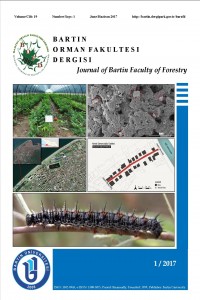Mikrokristalin selüloz ve odun unu ilaveli Polihidroksibütirat (PHB) kompozitlerinin solvent yöntemiyle hazırlanması ve karakterizasyonu
Öz
Petrol türevli
materyallerin doğada yok olma süreleri ve çevreye olan etkileri nedeniyle
alternatif ürünlere yönelme ihtiyacı ortaya çıkmıştır. Bu durum, biyopolimer materyallerin
gelişmesine ivme kazandırmıştır. Doğada kolayca bozunan bu polimerlerin mekanik
özelliklerinin düşük olması, destek materyalleri ile kullanımını
yaygınlaştırmıştır. Bu çalışmada, biyopolimer olarak laboratuvar ortamında solvent
casting yöntemi ile sentezlenen polihidroksibütirat (PHBs) ve ticari olarak
satın alınan polihidroksibütirat (PHBt), farklı oranlarda oranında odun unu
(OU) ve mikro kristalin selüloz (MKS) ile desteklenerek biyopolimer film
tabakaları elde edilmiştir. Elde edilen biyopolimerler üzerinde (scanning
electron microscope) SEM, (Thermogravimetric Analysis) TGA, (X-ray Diffraction)
XRD, (Fourier transform infrared spectroscopy) FTIR analizleri gerçekleştirilmiştir.
Çalışma sonuçlarına göre, PHBt örneklerinin termal dayanımlarının PHBs
örneklerine oranla daha yüksek olduğu, MKS’lerin PHB içerisinde odun ununa
oranla daha homojen dağımlar gösterdiği belirlenmiştir.
Anahtar Kelimeler
Polihidroksibütirat mikro kristalin selüloz odun unu kompozit biyopolimer
Kaynakça
- o Anderson, A.J., Dawes, E.A. (1990). Occurrence, metabolism, metabolic role and industrial uses of bacterial polyhydroxyalkanoates. Microbiology and Molecular Biology Reviews, 54: 450-472
- o Avella M, La Rota G, Martuscelli E, Raimo M, Sadocco P, Elegir G, Riva R (2000) Poly(3-hydroxybutyrate-co-3-hydroxyvalerate) and wheat straw fibre composites: thermal, mechanical properties and biodegradation behavior. J Mater Sci 35:829–836
- o Bartczak, Z., Galeski, A., Kowalczuk, M., Sobota, M., Malinowski, R. (2013). Tough blends of poly (lactide) and amorphous poly ((R, S)-3-hydroxy butyrate)–morphology and properties. European Polymer Journal, 49(11), 3630-3641.
- o Bhardwaj R, Mohanty AK, Drzal LT, Pourboghrat F, Misra M (2006) Renewable resource based green composites from recycled cellulose fiber and poly(3-hydroxybutyarte-co-3-hydroxyvalerate) bioplastic. Biomacromolecules 7, 2044–2051
- o Bruney, G., Lefebvre, G. ve Genser, K.L. (1998). Polyhydroxyalkanoates, biopolyesters from renewable resources: Physiological and engineering aspects. Journal of Biotechnology, 65: 127-161.
- o Davis, G., Song, J. H. (2006). Biodegradable packaging based on raw materials from crops and their impact on waste management. Industrial crops and products, 23(2), 147-161.
- o Fernandes, E. G., Pietrini, M., Chiellini, E. (2004). Bio-based polymeric composites comprising wood flour as filler. Biomacromolecules, 5(4), 1200-1205.
- o Forrest, J. A., Dalnoki-Veress, K., Stevens, J. R., Dutcher, J. R. (1996). Effect of free surfaces on the glass transition temperature of thin polymer films. Physical review letters, 77(10), 2002.
- o Hanna, M., Biby, G. ve Miladinov, V. (2001). Production of microcrystalline cellulose by reactive extrusion. US Patent 6: 228,213.
- o Hodzic A, Coakley R, Curro R, Brendt CC, Shanks RA (2007) Design and optimization of biopolyester bagasse fiber composites. J Biobased Mater Bioenergy 1:46–55
Preparation and Characterization of Microcrystalline Cellulose and Wood Flour Added Polyhydroxybutyrate (PHB) Composites through Solvent Method
Öz
The need to turn to alternative
crops has arisen due to the environmental extinction periods and environmental
impacts of petroleum derived materials. This has accelerated the development of
biopolymer materials. These polymers, which are easily degraded in the nature,
have low mechanical properties and are widely used with support materials. In
this study, biopolymer film layers were obtained from polyhydroxybutyrate,
which was synthesized by solvent casting method (PHBs) and polyhydroxybutyrate which
was supplied commercially (PHBt) have used as biopolymers. Polyhydroxybutyrates
were supported different ratios with wood flour and microcrystalline cellulose.
Scanning electron microscope (SEM), Thermogravimetric analysis (TGA), X-ray
diffraction (XRD), Fourier transform infrared spectroscopy (FTIR) analyzes were
performed on the obtained biopolymers. According to the results of the study,
the thermal resistances of PHBt samples are higher than those of PHBs and has
been determined that microcrystalline celluloses show more homogeneous dispersions
in PHB compared to wood flour.
Anahtar Kelimeler
Polyhydroxybutyrate microcrystalline cellulose wood flour composite biopolymer
Kaynakça
- o Anderson, A.J., Dawes, E.A. (1990). Occurrence, metabolism, metabolic role and industrial uses of bacterial polyhydroxyalkanoates. Microbiology and Molecular Biology Reviews, 54: 450-472
- o Avella M, La Rota G, Martuscelli E, Raimo M, Sadocco P, Elegir G, Riva R (2000) Poly(3-hydroxybutyrate-co-3-hydroxyvalerate) and wheat straw fibre composites: thermal, mechanical properties and biodegradation behavior. J Mater Sci 35:829–836
- o Bartczak, Z., Galeski, A., Kowalczuk, M., Sobota, M., Malinowski, R. (2013). Tough blends of poly (lactide) and amorphous poly ((R, S)-3-hydroxy butyrate)–morphology and properties. European Polymer Journal, 49(11), 3630-3641.
- o Bhardwaj R, Mohanty AK, Drzal LT, Pourboghrat F, Misra M (2006) Renewable resource based green composites from recycled cellulose fiber and poly(3-hydroxybutyarte-co-3-hydroxyvalerate) bioplastic. Biomacromolecules 7, 2044–2051
- o Bruney, G., Lefebvre, G. ve Genser, K.L. (1998). Polyhydroxyalkanoates, biopolyesters from renewable resources: Physiological and engineering aspects. Journal of Biotechnology, 65: 127-161.
- o Davis, G., Song, J. H. (2006). Biodegradable packaging based on raw materials from crops and their impact on waste management. Industrial crops and products, 23(2), 147-161.
- o Fernandes, E. G., Pietrini, M., Chiellini, E. (2004). Bio-based polymeric composites comprising wood flour as filler. Biomacromolecules, 5(4), 1200-1205.
- o Forrest, J. A., Dalnoki-Veress, K., Stevens, J. R., Dutcher, J. R. (1996). Effect of free surfaces on the glass transition temperature of thin polymer films. Physical review letters, 77(10), 2002.
- o Hanna, M., Biby, G. ve Miladinov, V. (2001). Production of microcrystalline cellulose by reactive extrusion. US Patent 6: 228,213.
- o Hodzic A, Coakley R, Curro R, Brendt CC, Shanks RA (2007) Design and optimization of biopolyester bagasse fiber composites. J Biobased Mater Bioenergy 1:46–55
Ayrıntılar
| Bölüm | Biomaterial Engineering, Bio-based Materials, Wood Science |
|---|---|
| Yazarlar | |
| Yayımlanma Tarihi | 1 Haziran 2017 |
| Yayımlandığı Sayı | Yıl 2017 Cilt: 19 Sayı: 1 |
Bartin Orman Fakultesi Dergisi Editorship,
Bartin University, Faculty of Forestry, Dean Floor No:106, Agdaci District, 74100 Bartin-Turkey.
Tel: +90 (378) 223 5094, Fax: +90 (378) 223 5062,
E-mail: bofdergi@gmail.com

